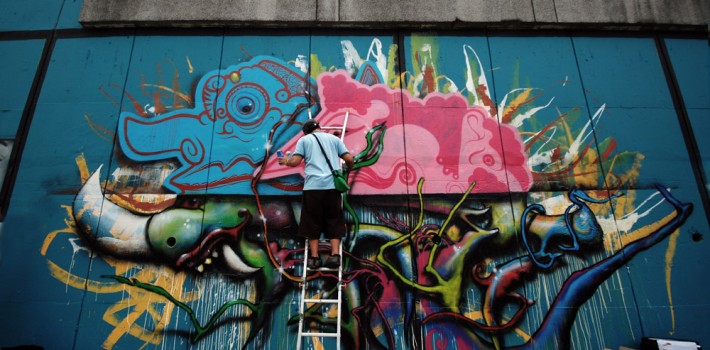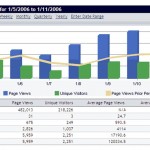In the previous article in this series we discussed the importance of website navigation – in a nutshell how not to let your visitors get lost and frustrated. Today’s topic focuses on not distracting attention away from your art.
Lets face it – it takes a huge amount of effort to bring visitors to your art website. Search engine optimization, social networking, and offline marketing all require great commitment and work to achieve results. Why then, after all that effort, would you want to distract the visitor’s attention away from your art?
You wouldn’t right? But it is truly amazing how many artist websites do just that.
An artist website is not the same as other websites. You are not trying to be a giant news hub where you make your money through advertising. On the contrary – the core of your artist website should be like a beautiful art museum or commercial gallery where all the attention is on the art. You want each visitor to STAY on your website for 3 or 5 or 10 minutes bathing in the quality and talent of your work. That’s what will lead to further contact and ultimately – sales.
Here are some prime contenders for the biggest art website distractions…
Flash Websites
I will go out on a limb here and say that for most (fine) artists, websites that make substantial use of Flash programming are not ideal. Flash is a sexy technology that works very well for entertainment-industry sites and some photography websites where wow-factor and pizzazz are important. Sometimes they work OK for fine artists but mostly not. The reason is that there is (mostly) just too much activity going on visually and the sites generally take too long to load. To put it simply – the website becomes self-conscious and attracts as much attention as the art. There are other practical problems with flash websites too – you can read more about these in our article: Are Flash Websites Good For Artists.
Our recommendation is to have a website which is predominantly HTML-based and to keep it’s personality in a supporting background role.
Lurid Color Schemes
Take note of the neutral colors you typically see on the walls in an art gallery setting. Those colors are chosen specifically to not distract from the art. Occasionally you might see a brighter-than-usual blue or turquoise used to complement (say) oceanic art but generally you will see pale pastels and mid to darker charcoals. These are the same colors that showcase art well on websites. Bright colors will distract from the work and focus attention on the design of the website. That’s great for website designers but not for you – the artist! There are some occasions where you can break this rule – specifically with some more abstract art styles. But unless you are working with an experienced designer play it safe and stay with neutral website colors.
Advertising
This is very simple. Do not – under any circumstances – put adds on your artist website – period! They will distract attention and take visitors away from your website. Your business is selling art – not advertising! If you have a blog in addition to your art website – it might be OK to have some very limited advertising there. Personally I wouldn’t do it though.
Having said all of the above however, there is one time when a very tasteful add might be ok – that would be if it is a promotion to sell your own art such as a small display add linking to an online-store.
Mouse-Over Image Enlargements
A small number of websites suffer from this problem which is a major major source of distraction. It happens like this: You visit a website gallery section and find a series of thumbnails and an enlarged image. As you mouse-over each thumbnail its enlargement appears in the enlarged window. So you click on the thumbnail to make the image stay in the enlargement window but it doesn’t respond – you can only see the enlarged image when you mouse over the thumbnail. This style of gallery presentation is tatamount to spitting in the face of galleries and collectors everywhere. It drives every visitor to your website absolutely nuts with frustration!
Music
Occasionally I visit an art website where there is a sound track playing in the background. Sometimes it matches and enhances the work but mostly it just distracts me and I leave. It’s a bit of a gamble really – firstly because the music can take over and secondly because there’s a good chance the visitor, while liking your art, may not similarly like your musical taste. If you’re going to add background music to your website you need to ponder the great question asked by Clint Eastwood in “Dirty Harry”: “You’ve got to ask yourself one question: ‘Do I feel lucky?'”! And – if you must add music be sure that you have permission to do so.
Outgoing Links
It’s fine and dandy to display links to other art websites and resources. But they must be placed in a separate section of the website – you could call it “Resources’ or “Community” or something similar. Don’t place them anywhere near pages that are displaying your art.
One very very important point with links too – make sure that they are all setup to open in a new browser window or tab. If they open in the same window as your website you have just lost your visitor from your website as soon as they click on a link.
These are just a few of the distractions that can take all-important visitor-attention away from the art on your website. Remember that you are a creator of a very high value product and the purpose of your website is to engage and interest your visitors in (1) your work, and (2) you – the artist. Nothing else!
Thanks for joining us. The next article in this series, “Big Artist Website Mistake #2” is now available for your reading pleasure! We’d love to hear your comments below….




Fantastic advice. All newbies to the Art Marketing world (and maybe some not so new) need to read your articles! Thank you!!
Great article. A simple website is the key. Marketer Seth Godin said that in most cases, if people notice the website, then you've already lost the sale. Plus, simple websites also tend to be a bit cheaper and easier to maintain than those fancy flash websites that requires a lot of money to build and a web designer to maintain.
Thanks for the appreciation and great comments Ruth and Nicolette. I like the Seth Godin comment a lot – I could probably have replaced the whole article with those few words of his 🙂
"Loading" in an artist website is a curse word. Is the worst thing you want to have in your site. Most visitors leave right away after waiting for a few seconds for images to "load". Same with music. Music is for musicians. That's what they are selling. A web page is a natural medium for a VISUAL artist and it should be used "as is". Don't add anything to it. Great article Daniel!
Your view is very perfect. But the thing is not only Art websites need to be navigational and user friendly but all other websites in the world needs to be like that.
Every website must be user friendly. Load quickly and informative and not a spam one.
-Austin
Thanks for this great series of articles.
I wonder about the point made for 'Mouse-over Image Enlargements.' I suppose it is annoying for some people, but I think the purpose of it is to prevent people stealing and using copy-righted images. Images that are static can easily be copied if your computer has a screenshot function that allows you to capture/crop the image you want.